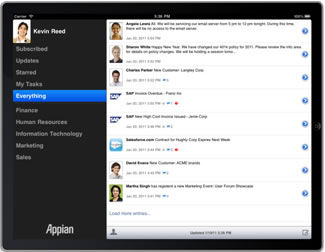Learning to compete on time is the key to surviving in intense marketplaces. Businesses that can’t do this risk being overtaken by more agile competitors or failing altogether. Appian BPM Suite 6.5 helps businesses compete in tough marketplaces. This integrated suite lets companies quickly transform operations and achieve the agility they need to survive in today’s marketplaces. Easy to install, Appian 6.5 lets businesses rapidly develop new process applications, see deeper into existing processes, and quickly adapt to evolving situations—all while supporting collaboration between departments and facilitating content and knowledge management.
Appian 6.5 provides a complete platform to design, execute, manage, and optimize business processes. It features a secure identity framework, an integrated portal environment, native document management and a standards-based, service oriented architecture (SOA). It leverages executable process models and extensive business rules, and offers personalized dashboard-style process analytics based on real-time reporting to achieve results, with native mobile support for iPhone/iPad and BlackBerry.
In addition, Appian scales linearly to allow business users to expand a BPM initiative throughout an enterprise using a single platform. For example, the U.S. Army’s Appian-based Army Knowledge Online (AKO) supports over 2 million users and 55,000 concurrent users. What’s more, Appian 6.5 is easy to use.
Below are 10 additional things you may find interesting about this BPM solution:
1. Speeds Application Development
Web services let an application quickly re-use programming logic, facilitate integration, and increase flexibility within a BPMS solution. Appian 6.5 encapsulates its Web services in a simple, reusable service object (called a “Smart Service”) that can be easily understood and deployed by business users. Appian 6.5 comes with an infrastructure designed to assist users in building a library of Smart Services for rapid orchestration and management of process applications, as well as more than 90 out-of-the-box process actions and 250 rule expressions for controlling actions and creating business rules.
2. A Flexible Portal Environment
Appian 6.5 has a flexible portal environment for interacting with, monitoring, and mapping process applications. Its portal environment lets business users target content based on rules, display content from a variety of sources, and quickly modify layouts with simple point-and-click technique. Its portal environment also allows business users to mash together data elements to deliver comprehensive views into a process. Meanwhile, the suite’s support for standard WSRP portlet consumption and JSR-168 lets users incorporate data from across any system into a dashboard view. Dashboards, individual content, or even rows in a report can be secured so only the right people view select information.
3. Encourages Collaboration Across Silos
The suite’s new Tempo environment encourages collaboration between business users with a social networking style interface for tracking and collaborating on key business events. Furthermore, features like discussion forums and group server can be combined to provide dynamic and targeted working areas for team collaboration. Appian 6.5’s Discussion Forums allow users to have threaded discussions on any topic. Each can be associated with content areas while individual posts can be rated for meaningfulness. Full Microsoft integration makes this BPMS easy to use for Microsoft SharePoint (and MS Office) users. SharePoint users can easily track process performance, handle tasks, and escalate actions from their Microsoft Share point dashboards.
 |
Appian’s Tempo environment supports Apple’s iPad
4. Scales To Customers’ Needs
Scalability and performance depends largely on usage in four areas—processes, analytics, content, and collaboration. To address large volumes, Appian 6.5 load balances process work across multiple physical servers by deploying multiple process engines. Its analytics maintains a high level of performance by providing a balance between user flexibility and administrator control. Its content component, which has been proven to scale beyond 11 million documents (Appian), provides a storage facility for depositing and searching documents inside and outside a process, while its collaboration component—comprising portal pages and groups—can be scaled as necessary. Some of the BPM suite’s largest installations have as many as one million pages and 200,000 groups (Appian).
5. Quickly Document Key Business Processes
Appian’s process modeler allows business users to quickly document key business process quickly, easily explore the services available across an enterprise for inclusion in a process, and build composite process-based applications rapidly. Delivered as a thin, web-based interface, the process modeler is based on Business Process Modeling Notation (BPMN) standards. It uses simple drag and drop interfaces, allows fields to be made dynamic and determined at runtime, and supports the standard concept of subprocesses. In addition, Appian 6.5 lets users drill down to preview and open subprocesses from the parent process.
6. Meets The Needs Of Real-Time Enterprises
Appian 6.5 employs a commercial off-the-shelf native database system optimized for real-time, in-memory performance. This simple to maintain database platform captures, analyzes, compares, and stores data at high speed and on high volumes. It operates as not only an in-memory environment, but also a relational database management system (with time series analysis) capable of handling data in memory as well as stored data on a disc. Data stored within the platform can exported to third party relational databases, like MySQL, Oracle, or MS SQL server, for independent analysis and reporting.
7. Quickly Design Forms Without IT’s Help
Appian 6.5 allows business users to quickly design web forms with little or no IT help. IT people can extend the Forms environment with new service objects, so they can easily create forms that integrate into existing IT systems. The Forms Designer is geared for users familiar with Microsoft Office, including common design elements needed to create a rich forms experience. Design elements in the Forms environment include things like tab layouts, expandable and contractible sections, field validations, rich text editing, and image embedding, as well as common form inputs, like text, numbers, and dates.
 |
Appian BPM 6.5 provides native mobile support for iPhone and Blackberry.
8. Easily Manage Security And Groups
The Appian Group Server provides dynamic organizational capabilities. It enables managers and administrators to manage security and groups quickly and easily in growing BPM environments. It simplifies administration of groups and roles with a dynamic rule-base system and saves administrators hours updating personnel changes across an organization. It also allows administrator to set up a variety of group types that include extended group attributes, public and private groups, rule-based group membership, and dynamic rule-based hierarchies. Rule-based membership and hierarchies allow groups to administer themselves as user and group attributes change.
9. Modify Processes In-Flight
The new suite lets users modify processes “in-flight” and make changes to processes during runtime. Users can open and edit in-flight processes as they are running, change process data, dynamically activate and change tasks, and trigger escalations and events. Running process can be modified to include new actions and steps. No downloads are required to modify processes in-flight nor any complex scripting or coding. Upon saving, the user can choose whether to apply the change to the individual processes or update the process model, forcing other processes to also adopt the change.
10. Provides Real-time Dynamic Analytics
Appian provides real-time, dynamic analytics on all process related data in the system, configurable through a web-based interface. The reports can be personalized to each user. Appian BAM performance can be displayed not only in graphical reports, but also directly inside the Appian Process Modeler, allowing process owners to view real-time and historical monitoring or editing the process. Report dashboards provide managers the ability to see real-time performance across all operations. In addition, security is managed at the process level, not the task level, providing tighter control of task security. Process security in Appian 6.5 can also be made dynamic, based on stages of the process.
Business must learn to compete on time if they want to survive in today’s global marketplaces. This means they must become more agile. Businesses that aren’t agile risk being overtaken by competitors or forced out of business. Appian BPM Suite 6.5 will help businesses transform operations and achieve the agility they need to outlast competitors and adapt to rapidly evolving situations.

















